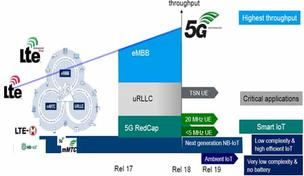5G NTN QoS:Resource type,priority,packet delay & error rate
Explain 5G NTN QoS parameters & their values including resource Type, Default Priority Level, Packet Delay Budget (ms), Packet Error Rate (PER) and Example Services.
Showing 25 posts (Page 7 of 136)
Advertisement
Explain 5G NTN QoS parameters & their values including resource Type, Default Priority Level, Packet Delay Budget (ms), Packet Error Rate (PER) and Example Services.
Discover 5G UE timers including T3510, T3517, T3580, T3581 and T3582 with their functions and roles in 5G NTN system.
Master key conformance tests for O-RAN equipment including EVM, ACLR, OBW, TAE, transmit on/off, power stability and receiver sensitivity with measurement approaches and standards.

Explore the benefits and drawbacks of 5G OpenRAN, including reduced costs, increased flexibility, and potential performance limitations.

Explore the 5G protocol stack, including the functions of Layer 1 (Physical), Layer 2 (MAC, RLC, PDCP), and Layer 3 (RRC).

Explore the distinctions between Primary Synchronization Signal (PSS), Secondary Synchronization Signal (SSS), and Extended Synchronization Signal (ESS) in 5G technology for frame synchronization.

Explore the applications of 5G Radio Dot in enhancing indoor coverage and delivering high-speed connectivity in 5G networks. Learn about its key features.

Understand the causes and phases of 5G Radio Link Failure (RLF) in 5G User Equipments (UEs), including failure at lower layers and during handover.

Compare 5G RedCap vs eMBB and explore difference between 5G RedCap and eMBB.

Overview of the 5G RRC connection setup procedure between the UE and 5G RAN, including message exchanges and RRC states.

Understand 5G RSMA (Resource Spread Multiple Access), its types (single and multi-carrier), benefits, and drawbacks in IoT and other wireless applications.

Explore the differences between RSMA and SCMA, two multiple access techniques used in 5G wireless technology, including their advantages and disadvantages.

An overview of 5G small cells, their types (femto, pico, micro, metro), benefits like improved coverage and capacity, and key manufacturers like Ericsson and Nokia.
Explore the role of 5G soft parameters like handover control, time to exit, SRS tuning, DMRS symbols, and retention priority in optimizing network performance and user experience.

Explore the distinctions between 5G speed (throughput) and 5G range (coverage), understanding their significance in 5G networks.

Explore 5 key advantages and disadvantages of 5G technology, including data speeds, latency, deployment challenges and security concerns.

Explore 5G throughput, covering downlink and uplink data rates, test procedures, minimum requirements, and related technologies.
Explore the essential 5G timers (T300, T301, T302, T304, T310, T311, T312) used at the User Equipment (UE) in 5G wireless communication, including their functions, start/stop conditions, and actions upon expiry.
Explore 5G NTN UE categories based on form factor & RF capability and by Network & Service Capability.The primary categories are handheld device and VSAT.

Explore 5G VoNR (Voice over NR) architecture, call flow, setup, registration, and termination messages. Understand the key features and requirements of VoNR in 5G networks.

Explore the key differences between 5G and 6G Key Performance Indicators (KPIs). This article compares bandwidth, data rates, latency, and other critical parameters.

Explore the distinctions between 5G and 6G, covering definitions, working principles, features, and future advancements in wireless technology.
Explore the key differences between 5G and LTE Advanced Pro in terms of data rates, frequency, bandwidth, compatibility, and more.
Compare 5G vs Satellite and explore difference between 5G NR and Satellite internet technology.

Explore the distinctions between 5G and WiFi 6 regarding speed, range, security, and applications to determine the best connectivity solution for your needs.
Advertisement